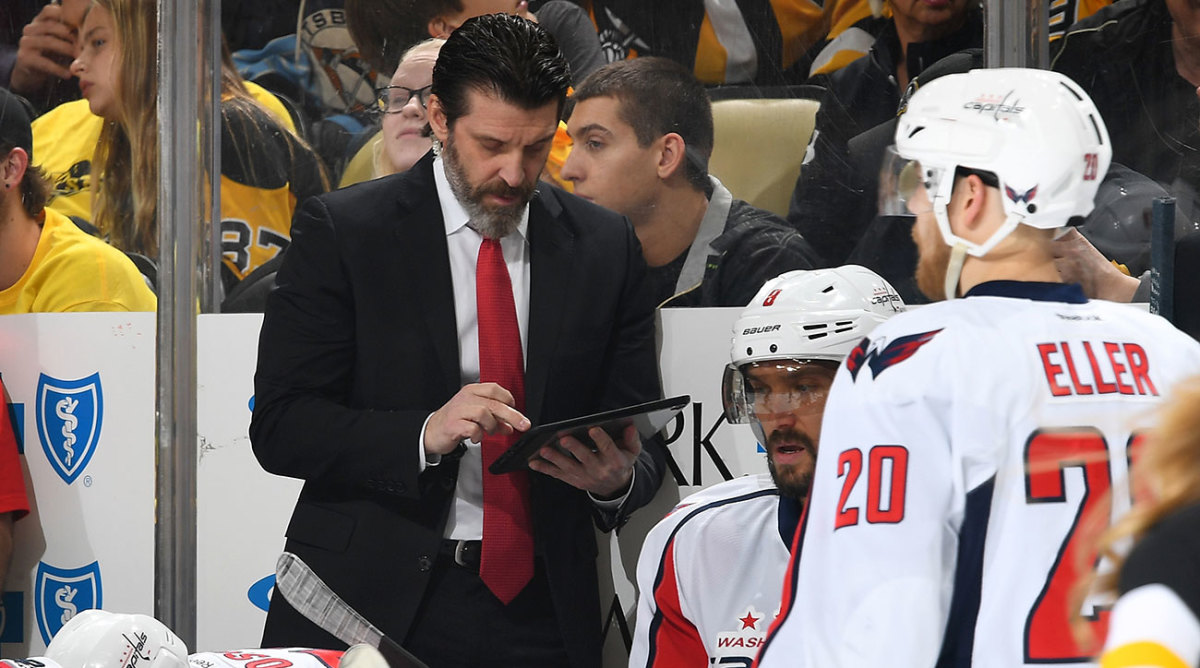For NHL Teams and Players, iPads Have Become an Important Part of the Game

The touchscreen generation is a catchall term encompassing mostly toddlers and tykes, though an exception should be made for hockey’s band of tech-savvy bench bosses. They are addicted like the rest of us, all hunched shoulders and glued eyes, furiously swiping and scrolling during breaks in the action. It is the kind of antisocial behavior that might get decried around their homesteads, if only it hadn’t evolved into such an integral tool at work. “Technology is part of the game,” says Hurricanes coach Bill Peters. “Better get onboard or be left behind.”
No one can claim ignorance or illiteracy anymore. Last spring the NHL unveiled a pilot program that equipped its playoff-bound clubs with 9.7-inch iPads, testing the system on a smaller group before expanding league-wide—and upgrading to 10.5-inch models—for the ‘17-18 season. Now each bench is outfitted with two or three tablets depending on the rink, as is the scorekeepers' bench, prepared for any officials' review, sheathed in protective cases and stored against the glass for live video review.
New Class of Russian Talent Ready to Take the NHL Postseason by Storm
Take Blaine Forsythe, for example. He is a mild-mannered, middle-aged Capitals assistant whose daily duties include helping oversee their forwards and managing their vaunted power play. He once owned a personal iPad “six or seven years ago, but I used it for about a year then quit.” Now he spends television timeouts watching breakouts, breakdowns, faceoffs, scoring chances, special teams sequences, even-strength sets … “It’s busy,” he says. “We’re pretty much on it every play, every shift. At least once or twice a game, it helps you in some form.”
The process starts behind the scenes, where Washington video coaches Brett Leonhardt and Tim Ohashi are responsible for clipping and flagging footage on the fly from their bunker cave of computer screens. From there Forsythe can queue whatever play he desires onto the iPad, which is loaded with XOS ThunderCloud software—no other apps, unfortunately for any Minecraft enthusiasts—and connected to a dedicated WiFi network that only Washington can access. For extra security, each coach also receives a unique login username and password.
When Forsythe was hired as Washington’s video coach in ‘06-07, technical adjustments had to wait until intermission, which consumed precious time. The Capitals were relatively ahead of the digital curve, hiring an outside company several years ago to set up iPads before they were standardized across the league. Typically, Forsythe and fellow assistants Lane Lambert and Todd Reirden will tap a player on the shoulder and slide the tablet their way, but some are proactive enough to seek feedback upon finishing a shift, removing their gloves and toggling themselves: Alex Ovechkin, for instance, enjoys reviewing how certain goalies defended his sizzling shot attempts. “He’s scored 600 goals,” Forsythe says. “I’m not going to tell him what to do.”
Of course, usage rates depend on individual dispositions. “I can’t say I’m all about that, to be honest with you,” Carl Hagelin says. “I don't think I’ve grabbed it once this year to rewind.” As a counterexample, the Pittsburgh winger motions across the locker room toward captain Sidney Crosby, whose rotating cast of linemates often lends itself to visual instruction. “I think it’s important for him to create chemistry, show what he’s seeing,” Hagelin says.
Unlike the monitors installed on the bench floors, controlled backstage by the likes of Leonhardt and Ohashi for offside and goalie interference challenges—which are then reviewed by officials on another tablet housed inside the visiting penalty box—the iPads are far more customizable in their capabilities. “Lots of times they’re really good for the special teams, particularly on the penalty kill where you can show guys on the bench before they go out again,” Devils coach John Hynes says. Some old-school souls, however, prefer an analog approach. “We use them a lot,” Blues associate coach Craig Berube says. “Too much, in my opinion. It’s constant. The players are asking to see stuff all the time. Sometimes I feel like it takes away from just watching the game. That’s the part I don’t like. But it is nice to have and look back on things.”
Ambiguous Goalie Interference Rules Continue to Bemuse NHL Ahead of Playoffs
Especially in the playoffs, when margins of error are thinned and one small advantage can tilt a series. Click, zoom, back on the ice. “To have that option is amazing,” says winger Tomas Tatar, whose Vegas Golden Knights sat one victory from sweeping Los Angeles entering Wednesday night’s Game 4. “You can see right away. You don’t have to wait.” And isn’t instant gratification a hallmark trait of the touchscreen generation? “The coaches are more competent on those things than I am,” Devils forward Blake Coleman says. “Maybe their kids taught them.”
Spare tablets are stored at every rink should any technical issues arise. In the ultra-rare event that the entire system fizzles, all tablets are shut down to maintain competitive balance, according to an NHL spokesperson. “Sometimes it freezes,” Forsythe says. “That’s usually the biggest issue. Earlier in the season, it was pretty much every other game that it wasn’t working for a full 60 minutes.” He wasn’t the only coach to log such a complaint, but the offline plan isn’t so terrible. After all, benches still come furnished with dry-erase whiteboards.
You know, like retro iPads.
































